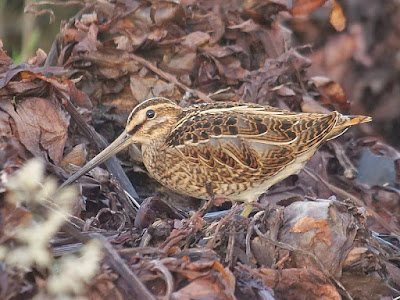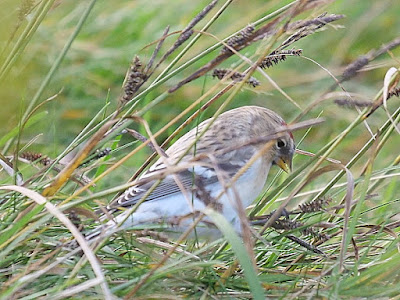Saturday 14
October. Gale force NW winds with intermittent heavy showers
restricted birding. A couple of hours watching the sea produced a handful of Kittiwakes, Fulmars and Gannets. An
afternoon walk to Valyie was more successful with 2-3 Waxwings, Blackcap, 20 Redwings, Fieldfare, Robin, Chaffinch, 50 Bramblings, Hawfinch, Lesser and the Horneman’s Arctic Redpoll and Siskin.
 |
| Waxwing at Leawart |
 |
| Hawfinch at Leawart |
 |
| Norwick providing shelter from the storm |
Sunday 15
October. The gale force NW winds had moderated by dawn
although were still strong and we felt watching the sea was our best option. In
five cold hours, at times being sleeted on, we witnessed a very impressive
northerly movement of 15,000+ Fulmars. A mesmerizing sight as they passed on a
wide front at a rate estimated to be about 50/minute (3000/hour). Amongst them
Dave picked out 3 ‘Blue’ Fulmars and
I managed one. I also saw 14 Long-tailed
Duck, 20 Kittiwakes, adult Iceland Gull, 30+ auks (those identified were 9 Razorbills
and a Black Guillemot), 2 Great Northern Divers, 3 Sooty Shearwaters (Dave saw more),
250+ Gannets and about 65 Snow
Buntings (2 singles and flocks appearing from below the cliff edge of about 15,
50 and presumably the same 15). An afternoon walk to Valyie showed little
change with 2 Waxwings, 10 Redwings, Fieldfare, Robin, Chaffinch, 30 Bramblings, Hawfinch, Lesser Redpoll and Siskin. Walking
back we also caught up with the juvenile Hen
Harrier that had been seen irregularly in north Unst since before I
arrived.
 |
| Starling and Redwing at Leawart |
 |
| Fieldfare at Leawart |
 |
| Waxwing at Leawart |
 |
| Common Snipe in Norwick |
Monday 16
October. The wind had lessened a bit and switched to SW
overnight. We walked down to Valyie and spent a couple of hours there, partly
sheltering in the shed and bus stop. It was soon obvious that most of the
migrants there had moved on with no winter thrushes or Bramblings in
evidence. We saw a Waxwing (flying from Leawart to Norwick), Robin, 4 Greenland Redpoll and Siskin. In the afternoon I spent 3
hours on East Hill looking unsuccessfully for Snow Buntings and anything else
notable. I saw 30 Golden Plover, 14 Curlew, 4 Hooded Crows and a Raven.
It was wetter than expected and an old bread bag didn’t do a very good job at
keeping my camera dry. It stopped working, not that there was much to
photograph.
Tuesday 17
October. My camera was more or less working again after a night on a
radiator. although the viewfinder was rather cloudy. We walked to Valyie
seeing the ring-tail Hen Harrier, 5 Blackcaps, 5 Redwings, Robin, Wheatear, 3 Brambling, 4 Lesser and
3 Greenland Redpolls
and a Siskin. We were back at
Millfield at about 10:30 and after tea and toast drove to Uyeasound. There were
21 Whooper and 29 Mute Swans, 24 Tufted Duck, a Long-tailed
Duck, 5 Goldeneye and a Whinchat at Easter Loch. We walked SW along
the coast seeing 2 Otters, 40 Wigeon, 30 Eider, 120 Long-tailed Duck,
3 Red-breasted Mergansers, a 2CY Glaucous Gull, 2 Black Guillemots, 2 Red-throated
Divers and 2 Twite. Dave received
news that his father’s health was deteriorating and we headed back so he would
be ready to leave (on same ferry/flight as me) if it was serious. A Hornemann’s Arctic Redpoll had just been found at Setter's Hill Estate and Dave dropped me there as we were passing. Three Tyneside birders were watching it near the pines but soon after I arrived it and the 10 or so other redpolls that it was with (Mealy, Greenland and a probable
Coues’s Arcrtic) flew off high east. I'd had identifiable
views of the Hornemann’s and a couple
of Greenland and Mealy Redpolls but didn’t see the
Coues’s. I wandered around the pines and after about 20 minutes some
redpolls reappeared at the far end before flying to the original
corner and then off high in the direction of the Health Centre. I counted 9
birds flying away both times but probably identified no more than 6, none being
either Arctic. I walked west, past a small estate where 2 calling redpolls flew
back towards Setter's Hill. I continued to Hunter's Wood, the rough ground by the Football pitch where I
could see the Tyneside birders were looking. There I came across the Hornamann’s Arctic Redpoll with 3 Greenland Redpolls feeding
in sallows and on the ground. The Hornemann's had very unstreaked underparts, unusually so in Dave's experience and very similar to the long-staying Valyie bird. Three hundred photos later they flew east a short distance.
The Tyneside birders had been watching them nearer the football pitch
before they flew in my direction, and later they flew high towards the Health Centre. I walked
over but failed to see them again although they were seen in the same area on subsequent days. Despite being a very mobile group of birds, and acting very much as if they were newly arrived, Dave took some detailed images on a later date showing identical feather anomalies to the Valyie bird.
 |
| Hen Harrier over Norwick |
 |
| Brambling at Valyie |
 |
| Greenland Redpoll at Valyie |
 |
| Rock Doves at Valyie |
 |
| Blackcap at Norwick |
 |
| Waxwing at Norwick |
 |
| Bobby's Bus Shelter, honouring Bobby Macaulay who used to cycle to the shelter in the mornings to catch the bus to school. The council planed to remove the bus shelter in 1996 but seven-year-old Bobby sent them a letter asking them not to as it was where he kept his bike while at school. |
 |
| Whooper Swans on Easter Loch |
 |
| Otter at Uyeasound |
 |
| a second Otter |
 |
| Otter's breakfast |
 |
| Greenland Redpoll at Setter's Hill |
 |
| Greenland Redpoll at Hunter's Wood |
 |
| Hornemann's Arctic Redpoll at Hunter's Wood |
 |
| a striking bird |







Wednesday 18 October. My very
enjoyable visit to Unst was at an end. Brenda and Dave were excellent hosts and
I’d seen a good haul of unusual birds, many of which we (mostly Dave) had
found. The long journey home began just before 07:30 when Dave took me to the
Saxa Vord bus stop. It was then bus, ferry, bus, ferry, bus to Lerwick where I
arrived just before 10:30. Highlights were 4 Whoopers identified amongst
the 50 swans on Easter Lock as we drove past (I’d seen 21 there a few days
before), 2 Eider, 3 Black Guillemots and 2 Red-throated Diver.
I dumped my bag, confirmed the early 14:00 departure to reach Aberdeen ahead of
the worst of Storm Babet and walked to Clickimin and Hellendale. There I saw Red-breasted
Merganser, 3 Collared Doves, 10 Hooded Crows, 4 Ravens,
Blackcap, 3 Goldcrests and 3 Redwings. The Hjaltland
departed promptly and I stayed on deck until we docked in Orkney at dusk.
Highlights were 34 Eider, 6 Long-tailed Duck, 6 Black
Guillemots, Sumburgh Head, 400 Fulmars, rugged Fair Isle and very
flat North Ronaldsay (the contrast between the two quite stark). I slept a bit
between Orkney and Aberdeen although an uncomfortable seat (the ferry was quite
full with it being the last crossing for at least two days) and heavy swell. Dave and Brenda hadn't managed to get a space on the ferry for their car and with John stabilised and no longer critical in hospital had provisionally booked on the next sailing (on Saturday).
 |
| Black Guillemot in Bluemull Sound |
 |
| Eider in Lerwick Harbour |
 |
| passing Sumburgh |
 |
| Fair Isle |
 |
| Fair Isle South Light |
 |
| North Ronaldsay |
Thursday 19 October. We arrived at
Aberdeen at 03:00 and I dozed until they started letting people off at 07:00. I
walked to Girdleness into the teeth of the storm, not helped by not being able
to leave my bag at the Ferry Terminal. Very impressive seas were breaking over
the harbour breakwaters making me very pleased we’d arrived before the worst of
Storm Babet. In a couple of hours I saw Wigeon, 2 Eider, Goldeneye,
Arctic Tern, 3 Kittiwakes, 3 Redwings and a Rock Pipit.
The seas were far too rough to see any birds moving and the foghorn provided
very little shelter with the winds whipping around both sides of it. I walked
back into town and caught a bus to the airport, arriving at14:15. My flight had
been put back from 16:10 to 17:30 and then 19:50 although I was instructed to
check in at the original time. Several changes later and after a long wait at
the gate for our plane to be prepared we boarded at about 18:40. Take off was
as bumpy as I can remember, probably more so, but we soon climbed out of the
extreme turbulence. We landed at Gatwick soon after 20:00 but then had to wait
almost 30 minutes for a gate to become free. Almost home but there was a sting
in the tail. Signaling problems between Three Bridges and Balcombe had caused
cancellation of all Littlehampton trains which now started at Haywards Heath,
clear of the defective signals. It was recommended I catch a Brighton train but
those were running late and then taking much longer to reach Haywards Heath.
The train was jam packed, more like rush hour Underground. Standing room only
and very hot. I fainted approaching Haywards Heath, the continual travelling
proving too much. Several nearby passengers got me and my bags off at Haywards
Heath and helped me to the Littlehampton train which was fortunately on the
adjoining platform. Fortunately there was a guard on the train who put me into
First Class and checked to see I was OK. Sitting down in a cooler environment I
soon recovered and was very pleased to see Megan and Cookie at Shoreham
Station. I was home about 22:15, almost 39 hours since I’d left Millfield. Despite
that I’m very keen to go back next year.
 |
| Aberdeen Harbour breakwaters |
Much to everyone's relief John improved sufficiently to be sent home.


































































No comments:
Post a Comment
Note: only a member of this blog may post a comment.